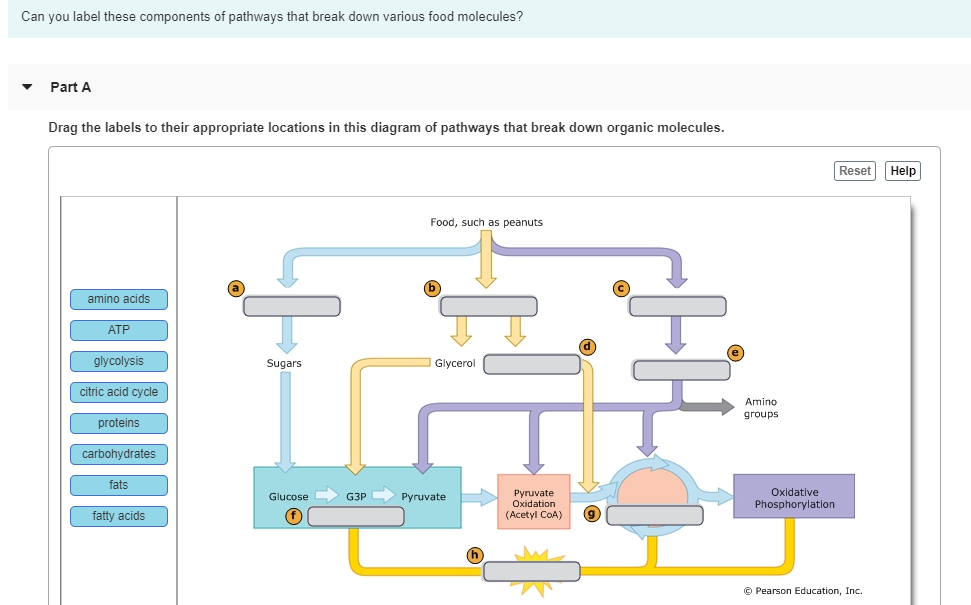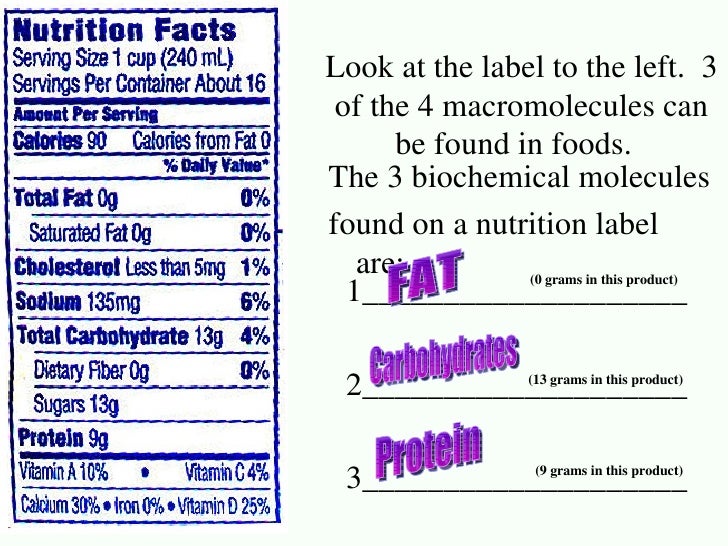41 lipids on food labels
Fat - Wikipedia The most common type of fat, in human diet and most living beings, is a triglyceride, an ester of the triple alcohol glycerol H(–CHOH–) 3 H and three fatty acids. The molecule of a triglyceride can be described as resulting from a condensation reaction (specifically, esterification) between each of glycerol's –OH groups and the HO– part of the carboxyl group HO(O=)C− of each fatty ... Lipid Types and Structures - Nutrition: Science and Everyday Application A family of organic compounds that are mostly insoluble in water; the three main types are triglycerides, sterols, and phospholipids. The main form of lipids in the body and in foods; made up of three fatty acids bonded to a glycerol backbone. The three-carbon backbone of triglycerides. Long chains of carbon and hydrogen molecules with an acid ...
How to Read the Nutrition Facts Label on Packaged Foods Most of it is in packaged foods and restaurant items. Limit salt to 2,300 milligrams (about 1 teaspoon) daily. If you have high blood pressure, kidney disease, or diabetes, or are African-American...

Lipids on food labels
Reading Food Labels (for Parents) - Nemours KidsHealth Food labels must include the ingredients that are in the product, listed in order of how much of the ingredient the food contains. Food-makers are required to clearly state on food labels whether the product contains these common food allergens: peanuts, tree nuts, milk, egg, fish, shellfish, soy, and wheat. The Science Behind Calories and Nutrition Facts Labels These main nutrients are fats ( lipids ), proteins and carbohydrates. Some calories you consume every day should come from each of the three nutrients. About 50 to 60% of your calories should come from carbohydrates, 30% of your calories should come from fat and 12 to 20% of your calories should come from proteins (©2020 Let's Talk Science ... Understanding Fiber - Diabetes Education Online On Nutrition Facts food labels, the grams of dietary fiber are already included in the total carbohydrate count. But because fiber is a type of carbohydrate that your body can’t digest, it does not affect your blood sugar levels. You should subtract the grams of fiber from the total carbohydrate.
Lipids on food labels. How To Read Food and Beverage Labels | National Institute on Aging For more information about food labels USDA MyPlate 703-305-2060 U.S. Department of Health and Human Services 877-696-6775 U.S. Food and Drug Administration 888-463-6332 druginfo@fda.hhs.gov This content is provided by the NIH National Institute on Aging (NIA). Understanding Food Labels and Health Claims - Maricopa This label is called a Nutrition Facts panel, which gives information on the number of servings per container, the number of calories per serving, and certain nutrients. Specifically, it lists the macronutrients and four of the most important micronutrients people need to pay special attention to, such as Vitamin D, Calcium, Iron, and potassium. Chapter 2 Flashcards & Practice Test | Quizlet Amounts of which types of lipids must be listed on food labels? a. monounsaturated fat b. trans fat c. cholesterol d. a and b e. b and c. e. The bottom portion of the Nutrition Facts panel on a food package: a. is identical on every label. b. lists the Daily Values standards. Federal Register :: Food Labeling: Revision of the Nutrition ... May 27, 2016 · (Response) In the notice on Food Labeling: Revision of the Nutrition and Supplement Facts Labels; Reopening of the Comment Period as to Specific Documents (80 FR 44302), we reported on the results of our consumer study “Experimental Study of Proposed Changes to the Nutrition Facts Label Formats” related to key aspects of the changes we ...
Food Labels: Carbohydrates | Home & Garden Information Center The 2015 Dietary Guidelines for Americans makes the following recommendations about daily consumption of unrefined carbohydrate foods, based on a 2,000-calorie diet: Choose fiber-rich fruits, vegetables, and whole grains often. 6 ounces of grain products, with at least half of this amount being whole grain products 2 ½ cups vegetables High and Low Biological Value Protein Foods | Eufic Jul 07, 2008 · Pay attention to the food labels. You rarely eat straight protein. ... Algal oil as a possible source of omega-3 fatty acid DHA to improve blood lipids in people ... Reading Food Labels | ADA - American Diabetes Association Put food labels to work. The Nutrition Facts labels on foods are really the key to making the best choices. We'll cover the basics so that these labels make shopping easier for you. You've heard it all. From carb-free to low-carb, to whole and empty carbs, it's hard to know what it all means. Blood sugar highs and lows aren't always ... Food Labels | CDC If you eat the whole thing, you are eating 8 times the amount of calories, carbs, fat, etc., shown on the label. Total Carbohydrate shows you types of carbs in the food, including sugar and fiber. Choose foods with more fiber, vitamins, and minerals. Choose foods with lower calories, saturated fat, sodium, and added sugars. Avoid trans fat.
Food Consumption and its impact on Cardiovascular Disease ... Oct 06, 2015 · Front-of-pack labels (FOP) on packaged food products considered healthy or unhealthy . Several Latin American countries have regulated FOP labels, including Ecuador’s traffic light label (implemented in 2014), and Chile’s warning label (being implemented over the next 4 years). Understanding Food Labels - Nutrition: Science and Everyday Application The FDA uses the following definitions for interpreting the %DV on food labels:4 5%DV or less means the food is low in a nutrient. 10% to 19%DV means the food is a "good source" of a nutrient. 20%DV or greater means the food is high in a nutrient. Lab 3 Lipids lab worksheet Spring 2020.docx - Course Hero View Lab 3 Lipids lab worksheet Spring 2020.docx from HMGT 1450 at University of North Texas. LAB 3 - LIPIDS Brandon Camacho MUST BE SAVED AS A PDF OR WORD DOC! HMGT 2400 Comparing Ingredients and ... This lab is completed using food labels. See the list provided for links and labels. If a link does not work, ... Interactive Nutrition Facts Label - Food and Drug Administration Nutrition Facts 4 servings per container Serving size 1 1/2 cup (208g) Amount Per Serving 240 Calories % Daily Value* 5% Total Fat 4g 8% Saturated Fat 1.5g Trans Fat 0g 2% Cholesterol 5mg 19%...
Lipids and the Food Industry - Human Nutrition Labeling laws allow foods containing trans fat to be labeled "trans-fat free" if there are fewer than 0.5 grams per serving. This makes it possible to eat too much trans fat when you think you're not eating any at all because it is labeled trans-fat free. Always review the label for trans fat per serving.
Nutrition Facts: What are Lipids? - UniversalClass.com Lipids are fats, and they provide the body with nine calories per gram, making them the most energy rich component of food. Lipids are different from carbohydrates and proteins because they do not dissolve in water. Fat has received a very bad reputation over the last few decades, but a certain amount of fat is essential for healthy body functions.
How to Understand and Use the Nutrition Facts Label | FDA You can use the label to support your personal dietary needs - look for foods that contain more of the nutrients you want to get more of and less of the nutrients you may want to limit. Nutrients...
How to Read Food Labels - AANMC For example, for a product to be called "low cholesterol" it must contain no more than 20 milligrams of cholesterol and 2 grams of saturated fat. For a food to be considered "low sodium", it may not have more than 140 mg per serving. 4, 5
Learning To Read Labels :: Diabetes Education Online On a nutrition food label, subtract the fiber from the total carbohydrate amount. When you read food labels, the grams of sugar are already included in the total carbohydrate amount, so you do not need to count this sugar amount separately. The grams of sugar listed include both natural sugars, from fruit or milk, and added sugars.
Should I check the cholesterol on nutrition labels? Major dietary cholesterol contributors — meat, fish, and chicken — often have no label. Having less than 4-6 oz of those per day and less than 2-4 eggs per week will generally keep your cholesterol reasonable. And that's a smart idea anyhow, to leave room for more artery-friendly fruits, veg, whole grains, beans, nuts, seeds, etc."
Food labels - NHS These labels provide information on the number of grams of fat, saturated fat, sugars and salt, and the amount of energy (in kJ and kcal) in a serving or portion of the food. But be aware that the manufacturer's idea of a portion may be different from yours. Some front-of-pack nutrition labels also provide information about reference intakes.
Lipids - Nutrition Essentials - Maricopa Understanding Food Labels and Health Claims. 6. Essential Nutrients. 7. The Process of Digestion and Absorption. 8. Carbohdyrates. 9. Lipids. 10. Protein. 11. Food Allergies. 12. Vitamins. ... Lipids are important fats that serve different roles in the human body. The three main types of lipids are triacylglycerols (also known as triglycerides ...





Post a Comment for "41 lipids on food labels"